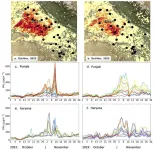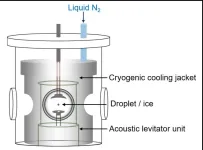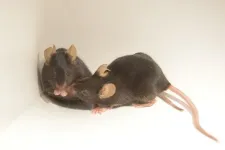(Press-News.org) Scientists at The Hospital for Sick Children (SickKids) have discovered a way to stop tumour growth before it starts for a subtype of medulloblastoma, the most common childhood malignant brain cancer.
Brain cancer presents a unique set of challenges for researchers – by the time a person experiences symptoms, the tumours are often so complex that the fundamental mechanisms driving the tumour growth are no longer easy to identify. A research team led by Dr. Peter Dirks is working to combat this challenge for sonic hedgehog (SHH) medulloblastoma.
In a new study published in Nature Communications, the researchers identify that a protein is responsible for the waking up of ‘sleeping’ stem cells and driving SHH medulloblastoma tumour formation and regrowth. By blocking this protein and preventing the stem cells from waking, the study demonstrates what could be a pivotal treatment strategy for the cancer, utilising cutting-edge genomic approaches in combination with functional experiments in a preclinical model.
"Our findings offer a novel strategy to target cancer stem cells, providing hope for more effective treatments against aggressive brain tumors," says Dirks, Senior Scientist in the Developmental, Stem Cell & Cancer Biology program and Chief of the Division of Neurosurgery.
Cancer interception in action
The research team began by examining cellular transitions that drove the development of SHH medulloblastoma tumours. They found that early in tumour development and after conventional treatments, a protein called OLIG2 would activate ‘sleeping’ stem cells, causing them to divide and grow into a tumour.
“There is order to how the cancer initiating stem cells undergo fate changes to form tumours. We can target an early transition event and intercept the entire process – essentially stopping the cancer in its earliest form,” says first author Dr. Kinjal Desai, a postdoctoral researcher in the Dirks lab.
During these transitions, the researchers uncovered a key window during which tumour progression could be blocked. By combining a previously established treatment with a small molecule called CT-179, which disrupts the OLIG2 protein, the research team were able to target the residual stem cells left after treatment and prevent them from re-awakening, effectively preventing tumour relapse.
Similarly for early-stage SHH medulloblastoma, CT-179 prevented the tumour from forming and significantly increased survival rates in the preclinical model.
Together with additional preclinical models in a study published simultaneously in Nature Communications from colleagues at Children’s Healthcare of Atlanta and QIMR Berghofer Medical Research Institute in Australia, the findings showcase what could be an effective new treatment for SHH medulloblastoma, as well as other brain cancers including diffuse intrinsic pontine glioma (DIPG).
The study complements recent research from the Dirks Lab in Nature, which describes the early stages of glioblastoma development. While future research will expand these findings into clinical trials for patients, particularly among those being monitored for relapse, the Dirks lab, part of the Arthur and Sonia Labatt Brain Tumour Research Centre (BTRC), is excited for the diagnostic potential this discovery presents.
“At SickKids, we’re already genetically testing every child with cancer to inform their diagnosis and treatments – our study goes beyond genetic testing to precision biology,” says Dirks. "I am excited for a future where this ‘magic bullet’ for early treatment could be combined with diagnostic tests to potentially prevent the cancer from developing at all.”
This study is funded by Canadian Institutes of Health Research (CIHR), Ontario Institute for Cancer Research, Terry Fox Research Institute, Canadian Cancer Society, Cancer Research UK, Stand Up to Cancer, Jessica’s Footprint Foundation, Hopeful Minds Foundation, b.r.a.i.n.child, Meagan’s Walk, Garron Family Cancer Centre, the Bresler family, and SickKids Foundation.
END
Research discovery halts childhood brain tumor before it forms
2025-02-04
ELSE PRESS RELEASES FROM THIS DATE:
Scientists want to throw a wrench in the gears of cancer’s growth
2025-02-04
Preventing the cell’s protein factories from making the notorious cancer-causing protein MYC could stop out-of-control tumors.
For decades, scientists have tried to stop cancer by disabling the mutated proteins that are found in tumors. But many cancers manage to overcome this and continue growing.
Now, UCSF scientists think they can throw a wrench into the fabrication of a key growth-related protein, MYC, that escalates wildly in 70% of all cancers. Unlike some other targets of cancer therapies, MYC can be dangerous simply due to its abundance.
In a paper that appears Feb. 4 in Nature Cell Biology, researchers at UC San Francisco ...
WSU researcher pioneers new study model with clues to anti-aging
2025-02-04
SPOKANE, Wash. — Washington State University scientists have created genetically-engineered mice that could help accelerate anti-aging research.
Globally, scientists are working to unlock the secrets of extending human lifespan at the cellular level, where aging occurs gradually due to the shortening of telomeres–the protective caps at the ends of chromosomes that function like shoelace tips to prevent unraveling. As telomeres shorten over time, cells lose their ability to divide for healthy ...
EU awards €5 grant to 18 international researchers in critical raw materials, the “21st century's gold”
2025-02-04
The new EU-funded consortium “ForMovFluid” will study how fluids transformed the materials inside the Earth's crust. Thanks to the Marie Skłodowska-Curie Action Doctoral Networks programme, ForMovFluid will fund the doctoral studies of 18 researchers, and train them to become elite experts in the field of geoscience.
Moreover, this project will allow us to understand the origin of the so-called critical raw materials, of vital importance for the energy transition. Over a period of four years, ForMovFluid “Marie Curie” researchers ...
FRONTIERS launches dedicated call for early-career science journalists
2025-02-04
FRONTIERS announces a new call for applications for its Science Journalism in Residency Programme, funded by the European Research Council (ERC). This
third call is exclusively aimed at early-career journalists and will remain open until May 6, 2025, at 17h00 CEST.
Science journalists with up to five years of experience are invited to apply for a residency at a research institution of their choice, in an EU Member State or a
country associated with the EU’s Horizon Europe Programme. The residencies, lasting between three to five months, should focus on frontier science topics, in
collaboration with scientists.
The ...
Why do plants transport energy so efficiently and quickly?
2025-02-04
The efficient conversion of solar energy into storable forms of chemical energy is the dream of many engineers. Nature found a perfect solution to this problem billions of years ago. The new study shows that quantum mechanics is not just for physicists but also plays a key role in biology.
Photosynthetic organisms such as green plants use quantum mechanical processes to harness the energy of the sun, as Prof. Jürgen Hauer explains: “When light is absorbed in a leaf, for example, the electronic excitation energy is distributed over several states ...
AI boosts employee work experiences
2025-02-04
A new paper in the Quarterly Journal of Economics, published by Oxford University Press, shows customer service workers using artificial intelligence assistance become more productive and work faster. The effects vary significantly, however. Less experienced and lower-skilled employees improve both the speed and quality of their work, while the most experienced and highest-skilled workers see small gains in speed and small declines in quality. The researchers also found that AI assistance can help worker learning and improve English fluency, particularly for international workers.
Computers and software have transformed the economy with their ability to perform certain tasks with far ...
Neurogenetics leader decodes trauma's imprint on the brain through groundbreaking PTSD research
2025-02-04
BELMONT, Massachusetts, USA, 4 February 2025 - In a comprehensive Genomic Press Interview, Dr. Kerry Ressler, Chief Scientific Officer at McLean Hospital and Professor of Psychiatry at Harvard Medical School, unveils groundbreaking advances in understanding the neurobiological basis of post-traumatic stress disorder (PTSD) and related anxiety conditions.
Dr. Ressler's research bridges the gap between molecular neuroscience and clinical psychiatry, focusing on how the amygdala processes fear and trauma at cellular and genomic levels. "Most proximally, I hope that our work may lead to novel approaches to fear- and trauma-related disorders, perhaps even to prevent ...
High PM2.5 levels in Delhi-NCR largely independent of Punjab-Haryana crop fires
2025-02-04
International collaborative research led by Aakash Project* researchers at the Research Institute for Humanity and Nature (RIHN) show an unequivocal contribution of crop residue burning (CRB) to air pollution in the rural/semi-urban regions of Punjab and Haryana, and a relatively lower contribution than previously thought to the Delhi national capital region (NCR). We have installed 30 units of compact and useful PM2.5** in situ instrument with gas sensors (CUPI-Gs) and have continuously recorded air pollutants in 2022 and 2023. New analytical methods have been developed to assess ...
Discovery of water droplet freezing steps bridges atmospheric science, climate solutions
2025-02-04
A groundbreaking University of Hawaiʻi at Mānoa study on the freezing of water droplets suspended in air sheds light on a key process in Earth’s water cycle: the transformation of supercooled water into ice.
Conducted using a novel cryogenically cooled ultrasonic levitation chamber, the research captures real-time molecular-level changes during the freezing process, mimicking conditions in the Earth’s atmosphere. This innovative setup enables researchers to observe how water droplets transition to ice at subzero temperatures, providing ...
Positive emotions plus deep sleep equals longer-lasting perceptual memories
2025-02-04
Researchers at the RIKEN Center for Brain Science (CBS) have uncovered how perceptual memories linked to positive emotions, such as joy or happiness, are strengthened during sleep. The study, published in the scientific journal Neuron, could help scientists understand the neurological basis for overcoming conditions like drug or sexual addiction.
Why do emotional events, whether positive or negative, create strong, long-lasting memories of external information such as music, scene smells and textures received at the events? We know that sleep is essential for memory consolidation, the process that turns new events into memories, but do not ...




